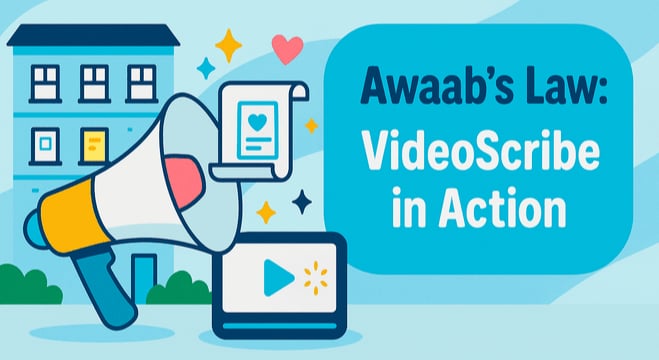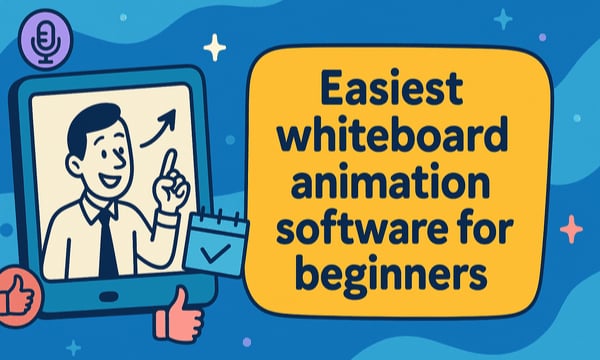For most of us, the thought of learning about the law is pretty intimidating. Not only is it a complex topic but few of us have time to read the huge volumes of text in dusty books you’re probably imagining.
But Christian Weaver is on a mission to change that. His YouTube channel, ‘The Law in 60 Seconds’ is designed to help ordinary people better understand the law and how it affects them.
This was especially important during recent protests in response to the death of George Floyd. Christian created an animated explainer video using VideoScribe to teach people about protest rights in the UK and what to do in certain situations. The animation was so effective, it was featured on the BBC News homepage and shared thousands of times.
So what went into creating this video and how was a dry complex topic turned into such a compelling animation? We’re excited to share our interview with Christian, where he answers those very questions!
Big thank you again to Christian for sharing your story with us.
1. Please could you tell us a little bit about yourself and your YouTube channel?

I’m currently a Pupil Barrister at Garden Court North Chambers in Manchester having studied at Nottingham Law School. My main areas of interest are immigration and asylum law; inquests and public inquiries; actions against the police and public authorities.
Before starting my pupillage I worked at INQUEST where I advised bereaved families on inquest procedures resulting from deaths in state care and detention. I also volunteered at Liberty, advising members of the public on issues like discrimination, actions against the police and data rights.
I’m really passionate about the law being accessible to all and providing strong representation to those most vulnerable in society. This led me to create my YouTube channel, ‘The Law in 60 Seconds’ where I share 1 minute videos explaining different legal matters.
2. What was your motivation for starting your YouTube channel?
The real motivation for creating ‘The Law in 60 Seconds’ was a recognition that although people understand the importance of the law, very few people take the time to become knowledgeable in it — often deeming it too difficult or a time-consuming task.
My #TheLawin60Seconds project identifies legal matters that relate to ordinary people and helps explain the legal rights and entitlements they have in the simplest of terms. The hope is that the information assists people in making informed decisions and gives them added confidence too. In addition to being an educational resource, I hope the channel will serve as the ‘lawyer friend’ that people often wish they had to advise them on their day-to-day legal affairs.
3. What made you choose to animate your video using VideoScribe?
To be most effective, I felt my video on protest rights had to:
Be able to be used IN a protest itself.
- It was important that viewers could obtain information from the video even if they were in a loud environment. Using animations in addition to my voice meant that even if a viewer couldn’t quite pick up every word I was saying, the animations could help fill in the gaps.
- I wanted to ensure that if an individual suspected that they might be about to be arrested, and therefore only had a short moment to view my video, they would be able to retain as much of its information as possible. The visual dynamic that the animations added to the video helped ensure that the information was memorable.
Be able to assist those who don’t speak English as their first language.
- People of all different backgrounds attended the protests and I wanted to ensure that even if English was not a person’s first language, they could still find value in the video. The animations played a big part in making this possible, helping communicate the message in a way that everybody could understand.
Be able to draw people in.
- Many people felt it extremely important to attend the protests, evidenced by the fact that they were not dissuaded from doing so by the pandemic. I was aware that this passion may lead to some having minimal interest in the legal consequences of their actions, and subsequently worried that for many, researching the law might be the last thing on their agenda. With that in mind, the video thumbnail had to encourage even those who didn’t have an interest in the law to watch it. A video of my face might not do that, but I felt a colorful animated video could!
Be helpful and suitable for children.
- Because of their added vulnerability, I wanted children in particular to know their rights. I thought it was particularly important that all children were aware that an appropriate adult (such as a parent) must be with them before they could be interviewed by the police. I was aware that the average 15 year old might not bother watching a 60 second video of a lawyer talking, but they might be tempted to watch a 60 second animated video.
I chose VideoScribe over other animation software because it met all my needs. I have no intention of becoming a ‘pro-animator’, I just wanted to create a quick video to get my message out there and VideoScribe consistently came up as the easiest to use. I was really impressed with the tutorials that come along with VideoScribe and these were all I needed to create the video, it was the perfect option.
4. What’s the response to your video on protest rights been like?
It’s been very positive. The video has been viewed over 30,000 times across social media and it was featured on the BBC News homepage. The BBC have been really supportive of my channel from the start and have helped get the information out to a wider audience.
I’ve also had very positive feedback specifically about the animation element with Black Lives Matter UK themselves sharing the video.
5. Could you tell us a little about your process for creating videos?
- I start by writing my script on Evernote (a note taking web tool).
- Then I use my iPhone to record myself reading the script.
- After that I use a free converter to change the audio file into the right format for VideoScribe and import it.
- I then create my animations over the top of the voice-over, stopping to watch tutorial videos created by VideoScribe where needed. These were really helpful as I had no previous experience using the tool.
6. What’s your best advice for other VideoScribers wanting to make educational videos that grab attention?
My main three tips would be:
- Be confident in your animations. There may not be an image for every single thing you want to say but by using multiple similar pictures, you often can still make the point.
- Whilst creating your videos, regularly watch them back to ensure you’re on the right lines. We all lead busy lives. You don’t want to waste time going back on things that could have been rectified much earlier.
- Make the animations WORK FOR YOU. If you need to explain a tricky concept then go for it! Don’t try and oversimplify it. Have faith that the combination of your voice and animations will make the concept easier to understand.
If you'd like to create educational videos like Christian then start a free 7-day trial of VideoScribe today 👇



.png)


![How to create animation magic [3-part guide to video success]](https://blog.videoscribe.co/hubfs/How%20to%20create%20animation%20magic%20guide%20VideoScribe.png)





COMMENTS